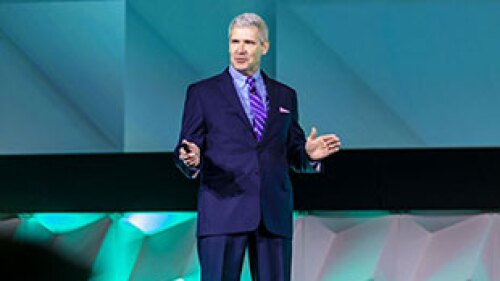When it comes to planning and funding metropolitan transit systems, regional cooperation and buy-in is essential, said panelists at a session organized by the ULI Infrastructure Initiative and the ULI Rose Center for Public Leadership last week during ULI’s Fall Meeting in Denver, Colorado. Speakers from Minnesota’s Twin Cities, Denver, and North Carolina’s Research Triangle talked about what it takes to get support for—and votes to fund—transit.
In the Twin Cities, two Chambers of Commerce have come together to launch a transit push. Will Schroeer, the first ever joint employee of the Minneapolis and Saint Paul Chambers of Commerce, described the way that his team is reframing transit advocacy: while acknowledging its environmental and equity benefits, his initiative and its partners are making the case that transit is essential for jobs, growth, and continued economic competitiveness.
A to-scale map used by Schroeer’s transit campaign compares the transit networks of various metropolitan regions throughout the country– this, he says, is serving as a wake-up call for Twin City business and political leaders. “This map shows what our competition is up to,” he said.
Transit is an essential component of a modern city’s infrastructure Schroeer claimed, comparing a city trying to compete without transit to a cell phone being sold without a camera, a remark that became one of the most Tweeted soundbites of the conference. The region’s two Chambers and their allies are leading a push to fund an expanded system from a mix of state and county sources.
Kathleen Osher, Executive Director of Denver’s Transit Alliance, shared some of the lessons learned from the region’s transit campaigns. After the failure of the Guide the Ride effort in 1997, the region regrouped. A new campaign, with targeted messaging, a groundswell of business support (which was lacking in the previous effort), and endorsements from the region’s 32 mayors, resulted in the approval of a 1 cent sales tax increase dedicate to transit expansion in 2004.
“I can’t overemphasize how important it is to know your voter,” Osher said. The biggest surprise from the focus groups the campaign conducted? Women over 60 were among transit’s biggest supporters. “For them,” Osher said, “transit represented freedom. It meant that they could come downtown and have lunch with the girls.” This was not a constituency that transit advocates would typically have courted in the campaign.
As it turned out, the vote was the easy part. The economic collapse of 2008 gutted sales tax revenues, jeopardizing construction schedules. The region is considering its best path forward, which might include a new vote to channel more funding to the system. In the meantime, Osher’s group is now working with partners in the region to make sure that the benefits of the area’s $6.5 billion transit investment are distributed equitably.
Jon Wilson, principal at landscape architecture firm Kimley-Horn and Associates, gave a sober assessment of the potential for regional transit investments in North Carolina’s Research Triangle. The region’s planning agencies are projecting high population and employment growth, and have identified transit investments as key to allowing the region to accommodate that growth without gridlock.
How to fund the system, however, has proved challenging. Until recently, a vote to fund transit with sales or property tax increases wasn’t permitted by state law. Although this hurdle was cleared in 2009, it will take separate votes of the region’s three counties to fund the system. Leaders in Wake County, the region’s most economically important county, have not yet scheduled a vote.
What does it take to build a regional groundswell for transit, especially when voting is involved? These three examples highlight the need for support from the public, from elected leaders, and from the business community. They also show how a region’s values can offer opportunities for tailored messages about how transit can help a community achieve its goals.


